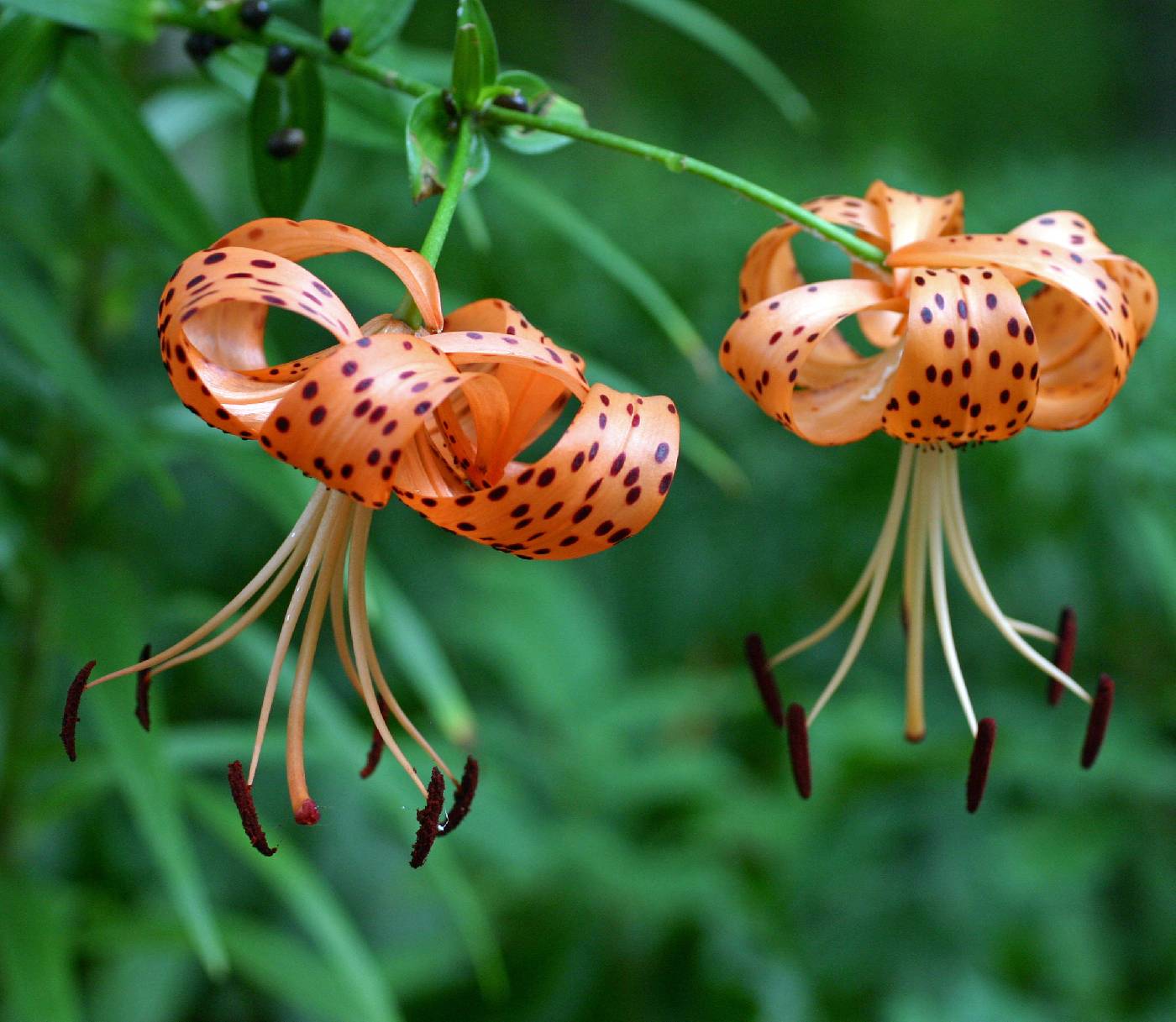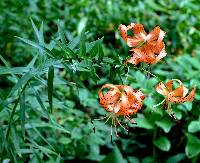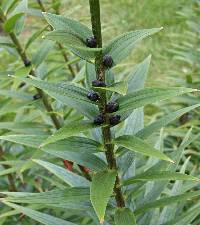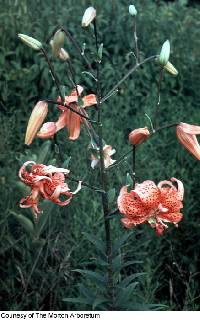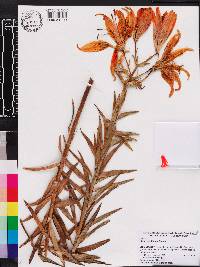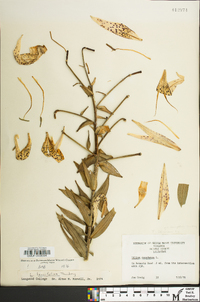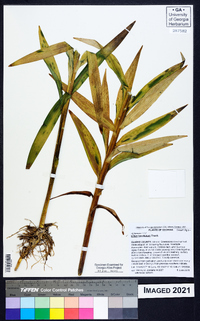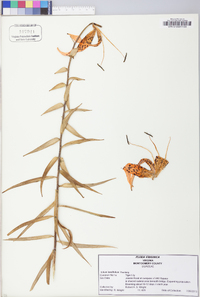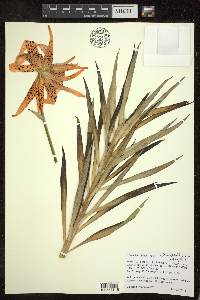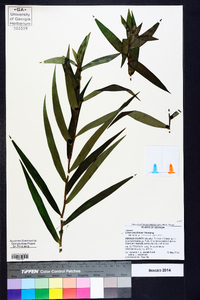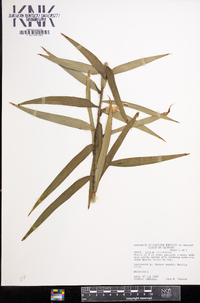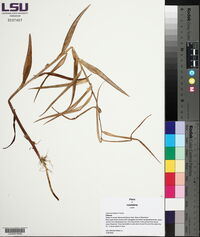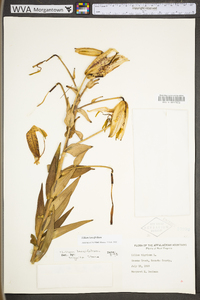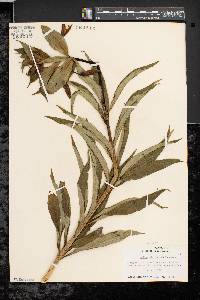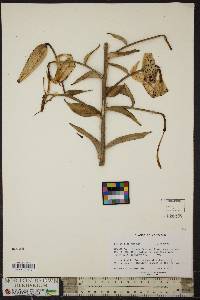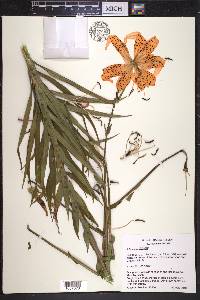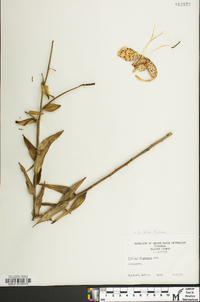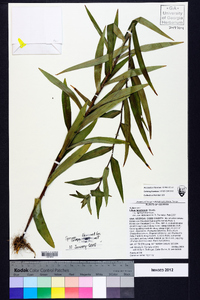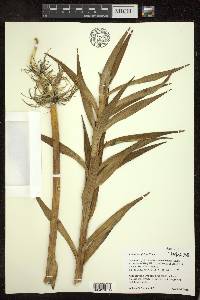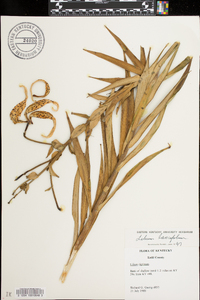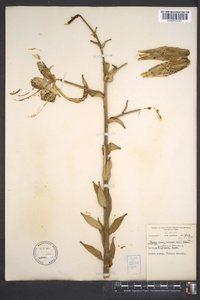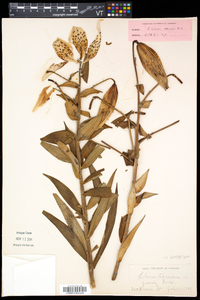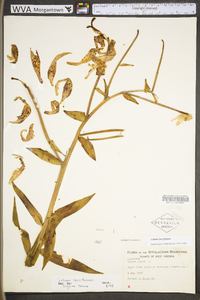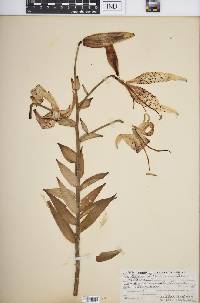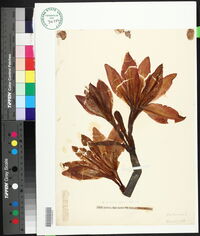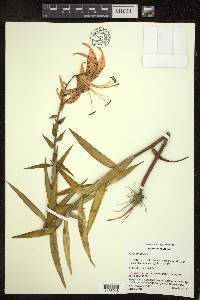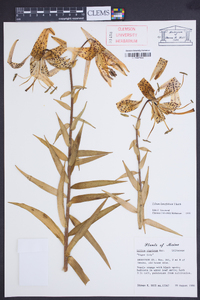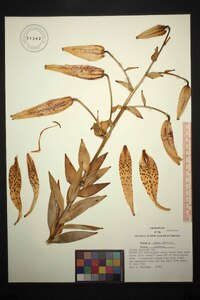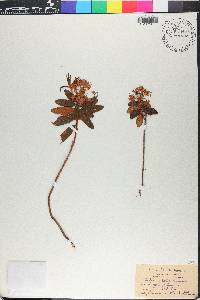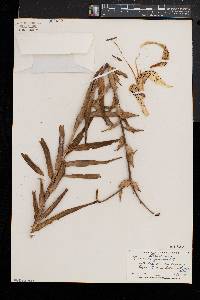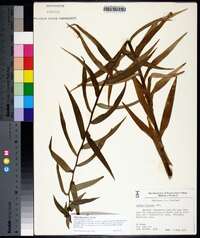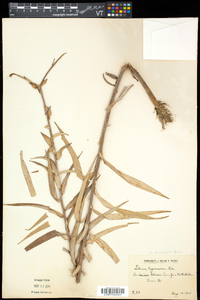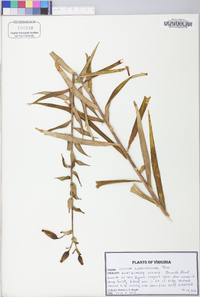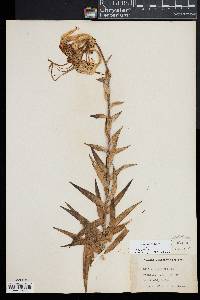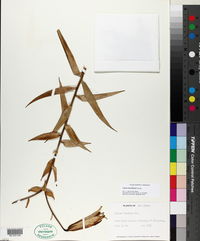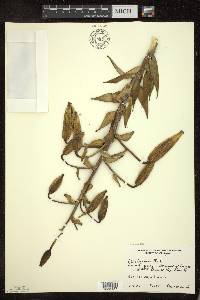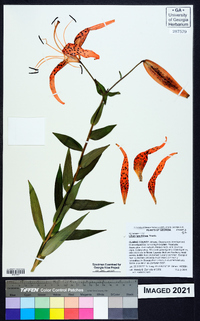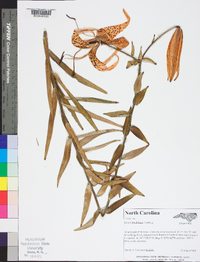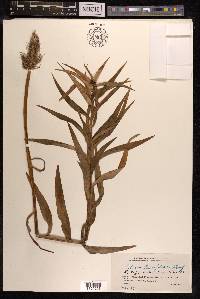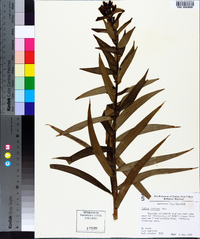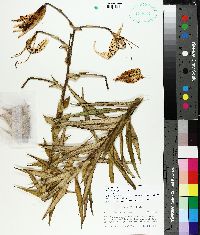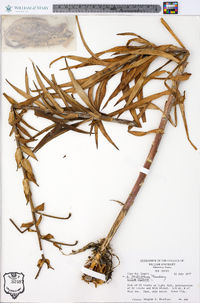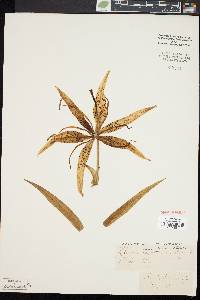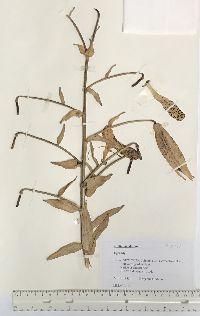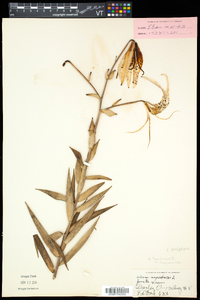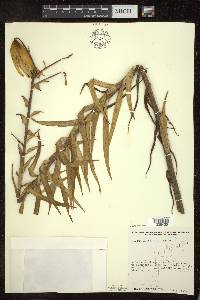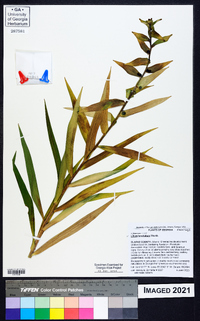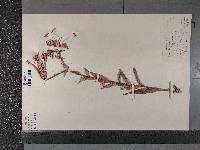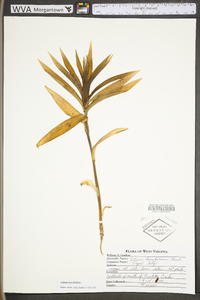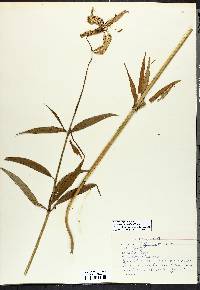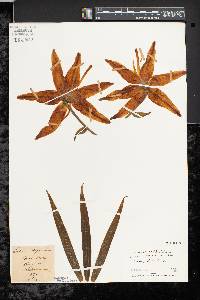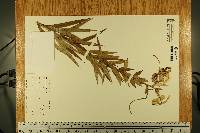
|
|
|
|
Family: Liliaceae
Lance-Leaf Tiger Lily
|
Bulbs widely ovoid, 3.5(-8) × 4-8 cm, ca. 0.7-0.8 times taller than wide; scales broad, unsegmented, longest ca. 3-4 cm; stem roots usually present. Stems white-lanate, purplish, to 2 m. Buds usually flat-sided, somewhat triangular in cross section. Leaves scattered, horizontal and drooping at tips, 10-15(-18) × ca. 1.5 cm, ca. 3-6(-10) times longer than wide, distal bearing 1(-3) dark purple axillary bulbils; blade lanceolate, often narrowly so, margins not undulate, papillose, apex white-lanate, narrowly acute (rounded in distal leaves). Inflorescences racemose, 3-6(-25)-flowered. Flowers pendent, not fragrant; perianth Turk´s-cap-shaped; sepals and petals reflexed ca. 1/5-1/4 along length from base, orange with many purple-brown spots, not distinctly clawed, 7-10 × 1-2 cm, adaxial base bearing pubescent strip; sepals not ridged abaxially; stamens strongly exserted; filaments very widely spreading, diverging ca. 25° from axis; anthers purplish, ca. 2 cm; pollen rust; pistil 6-9 cm; pedicel sometimes dichotomous, stout and relatively short, to 10 cm. Capsules 3-4 cm. Seeds not counted. 2n = 24, 36. Flowering late summer (mid Jul--early Sep). Roadsides, railroad banks, near dwellings; 0--ca. 1000 m; introduced; N.B., N.S., Ont., Que.; Ala., Conn., Del., D.C., Ill., Ind., Iowa, Ky., La., Maine, Md., Mass., Mich., Minn., Mo., Nebr., N.H., N.J., N.Y., N.C., N.Dak., Ohio, Pa., R.I., Vt., Va., W.Va., Wis.; Asia (China). Throughout most of modern botanical history this Chinese lily has been known as Lilium tigrinum, but recent nomenclatural reassessment affirms that Thunberg´s description, published sixteen years earlier than Ker Gawler´s, applies to this species. Though many North America species are known vernacularly as tiger lilies, the name is properly applied only to this one. Along with L. candidum, it is considered to be among the earliest domesticated lilies (H. D. Woodcock and W. T. Stearn 1950), no doubt because it is handsome, easy to grow, and the bulbs are edible and substantial. It is widely planted in North America, usually as a sterile triploid that is best propagated from the bulbils. Perhaps the hardiest garden lily, Lilium lancifolium is a widespread but sporadic garden escape, and roadside lilies near habitation in eastern and northeastern North America are often this species. Despite its general use in gardens, it seems to be naturalized only in the better-watered eastern portion of the continent. In North America, the tiger lily is rather easily diagnosed by its truly lanceolate and widely sessile alternating leaves that bear dark bulbils on the upper stem. The mature buds are usually high-shouldered and taper rather evenly to a flattish apex with three greenish, terminal, rounded processes. No native lily consistently displays any of these features.
Perennial herb with a bulb flowering stem to 2 m tall Leaves: numerous, alternate, stalkless, horizontal with drooping tips, 10 - 18 cm long and to 2 cm wide, narrowly lance-shaped with a pointed tip (rounded on upper leaves). Dark purple bulblets are produced in the axils of upper leaves. Inflorescence: an upright, terminal cluster (raceme) of three to twenty-five flowers raised on a stout stalk. Flowers: long-stalked, nodding, orange with purplish brown spots inside, 7 - 10 cm long, 1 - 2 cm wide, fused at the base, Turk's-cap-shaped, with six tepals that curve backward to nearly the base. There is also a hairy strip basally within the flower. Stamens six, strongly exserted. Filaments elongate and widely spreading. Anthers purplish. Fruit: a three-valved dehiscent capsule, upright, brown at maturity, 3 - 4 cm long, more or less oblong egg-shaped with a constricted base. Seeds numerous and flat. Bulb: whitish, often stained brown, widely egg-shaped, scaly. Similar species: This lily is easily distinguished by its alternate, lance-shaped leaves that bear dark bulblets on the upper stem. Flowering: late July to mid-August Habitat and ecology: Introduced from Asia, and commonly cultivated as an ornamental. An occasional escape from cultivation, occurring in weedy habitats. It is persistent in long-vacant lots. Occurence in the Chicago region: non-native Notes: Lilies, as a whole, are highly regarded for their beauty and are of great commercial importance. Thousands of hybrids have been developed. However, native North American species do not thrive well in gardens and many suffer from excessive collecting. It is best not to remove them from the wild. Etymology: Lilium means lily. Lancifolium means "lance-shaped leaves." Author: The Morton Arboretum Stem stout, 6-12 cm, cobwebby especially above; lvs very numerous, alternate, linear to narrow lanceolate, sessile, the upper rounded and clasping at the base and with axillary bulblets, the lower 10-15 cm, fls several in a raceme, the stout, widely divergent pedicels subtended by small lvs; tep recurved, orange-red with many purple-brown dots, 7-10 cm, bearing a pubescent strip basally within; 2n=24, 36. Native of e. Asia, often escaped from cult. about dwellings and on roadsides in our range. July, Aug. (L. tigrinum) Gleason, Henry A. & Cronquist, Arthur J. 1991. Manual of vascular plants of northeastern United States and adjacent Canada. lxxv + 910 pp. ©The New York Botanical Garden. All rights reserved. Used by permission. From Flora of Indiana (1940) by Charles C. Deam Indiana Coefficient of Conservatism: C = null, non-native Wetland Indicator Status: N/A |
|
|
|

